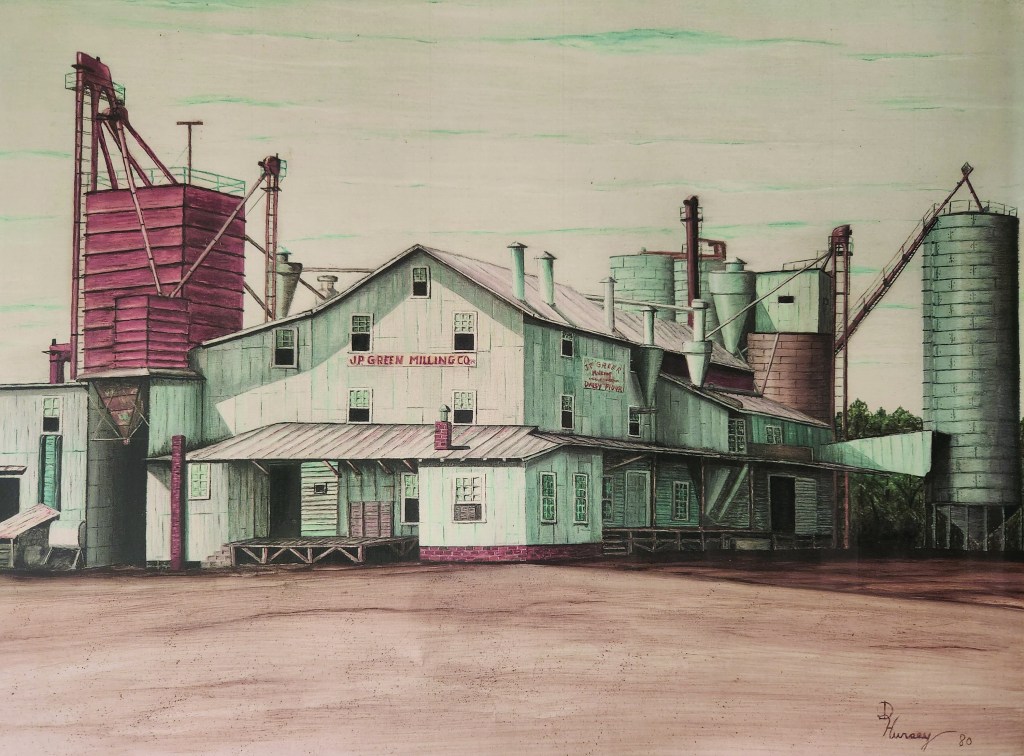J.P. Green Mill featured on print for Davie museum
Published 7:49 am Monday, November 6, 2023
|
Getting your Trinity Audio player ready...
|
By Mark Hager
President, Forks of the
Yadkin Davie County
History Museum
A Davie County museum is in the works, and the sale of a print of a Mocksville structure will help with the funding.
The historic J.P. Green Milling Company (1813-2021) painting, by local artist Donald Hursey, is being re-printed by the Naylor family.
Prints will be available at Daniel Furniture, 848 S. Main St., Mocksville, 8 a.m.-5 p.m. Monday, Tuesday, Thursday, Friday; 8 a.m.-noon Wednesdays; and 8 a.m.-4 p.m. on Saturdays, 336-751-2492. The 20- by 24-inch prints are $75 each.
The Mocksville mill has quite the history.
On Feb. 2, 1813 Peter Saner (Sehner) and Anny Smith were married. The Saner family was one of many Palatinates German’s that settled before the Revolution in parts of Mecklenburg and Lincoln Counties, NC, possibly a descendent of a Jacob Zurn.
In the late 1730s through 1740s, German migration came in large numbers from Pennsylvania down the Great Wagon Road into North Carolina.
Before leaving England, they cleared multiple custom houses and became legal “English Subjects.” Afterward, they arrived via the Delaware River into Philadelphia, Pa. The sheer numbers derived the nickname “Pennsylvania Dutch,” which historians are quick to point out an error that “Dutch” was mispronounced as it was more accurately derived from “Deutch.”
Dutch refers to Holland and Deutch indicates German.
In any case, a corresponding large migration of Scotch-Irish families mixing with English Quakers, and other similar groups, commonly confused the term. Pennsylvania “Dutch” became the slang of migration.
After arriving in the Carolina Backcountry (1730s-1750), the German settlers witnessed name changes and in many cases complete anglicization.
The Schneider’s became Snyder or Taylor and Shumacher’s became Shumaker or Shoemaker and on and on.
In 2015, famed NASCAR driver Dale Earnhardt Jr. traveled to Germany to trace his family ancestry, like the Sain, Hagers and many other Palatinate German’s families. The Earnhardts arrived in the area in the 1740s.
After filling in the Catawba River areas and building farms and mills, pioneer sons moved toward the Yadkin areas of what is now Davie and Rowan counties.
Peter Saner had purchased property in current Davie County which was originally Rowan. Like the term “Deutch” to “Dutch,” the name “Saner” experienced transition from Zurn to Sayne, Saner, Saine, and finally Sain.
After constructing a mill on the nearby creek, local residents referred to the creek as “Dutchman’s” Creek. The land was situated along Dutchman and Cedar Creek.
Before the mill, the original name was interchanged due to the Bryan family which owned much of the area where the creek flowed in Northern Rowan now called Davie County. Some old maps use the name Bryan Creek instead of Dutchman Creek.
By the mid 1800s many mills dotted Davie County. In this research, as many as 18 mills provided service to the local farming community.
However, the location of the “Saner” or Dutchman’s Creek” Mill grew more prominent than others.
Peter Saner sold the land and mill to William Dulin in 1821. The Dulin family sold it soon after to Thomas Gibbs. John Lynn purchased the property in 1829. The mill developed a new nickname as the Lynn or Linn Mill. The Lynn (Linn) and Sain families continued with mill operations.
In 1860, Albert Sheek purchased the mill where it remained in operation.
Following the Civil War and Reconstruction, the mill faltered. Hard times led to bankruptcy for many. Davie County Sheriff S.A. Kelly sold the mill and property at a public auction in 1870.
The new owners were W.L. Brown, R.D. Brown, and J.D. Adams. The sale carried with it a name change to – Browns Mill.
Also, by this time, the road from Mocksville to the mill drew a reputation. The bridge built adjacent to the mill could become treacherous during rainy periods. The road coming down to the mill area was commonly used.
On good days with warm weather, nearby residents would frequent the mill. A popular mill pond attracted fishing opportunities, as well as picnics and swimming excursions.
The well-worn road heading down to the mill proved treacherous and developed a nickname – The Mud Mill Road. The road name and mill both shared the common nickname. At least, when used locally, otherwise the Browns Mill name continued. Much of the road danger centered below the old Whitaker Church Cemetery.
In either direction, the ruddy approach to the bridge adjacent to the mill over Dutchman Creek proved treacherous. On March 15, 1880 a wagon crossing the bridge overturned due to a rain swollen creek causing the drowning of a Miss Racheal Hampton.
At the time period of the drowning, the “Mud Mill” or Browns Mill was owned by the Frits and Dulin families. With the Dulin family having a controlling interest in the mill, the mill developed another name – Dulin’s Mill.
In 1883, the mill changed ownership with its purchase by J.N. and W.F. Summers.
Then, it returned to the Brown family in the 1890s.
Just after the turn of the century the Brown Estate sold its land containing the mill to Swift Hooper. He resided in Guilford County and it appears mill operations were in decline.
By 1908, the mill and the property around its location was purchased by W. Gaston Allen. In a meeting in 1911, Gaston Allen listened to a proposal by J.P. Green to purchase the Old Mill but not the property.
Electricity changed the need for water to power the mill. The railroad coming into Mocksville made a circle and stopped. In that location J.P. Green saw opportunity.
Stockholders for this enterprise provided the funds and the old mill was purchased. The mill was disassembled and moved to the current location adjacent to the railroad tracks on Depot Street.
The mill name changed once again to J.P. Green Milling Co. It went into operation on Jan. 1, 1912, and remains a milling operation today. The original stockholders were: J.P. Green, M.F. Booe, B.R. Steelman, J.F. Garwood, H.H. Smith, and S.O. Rich.
The original site of Browns Mill, Mud Mill, Dulin Mill, Linn’s Mill, or Saner’s Mill was purchased once again by the Summers family.And, an attempt was made to start up the old mill, but the mill and dam were destroyed due to an explosion in March of 1915. With the mill pond gone, no other attempts were made to continue mill operations. The Old “Mud Mill Road” was no longer needed as a common road. The road from which it linked to Mocksville changed. No longer the road to “Mud Mill.” Instead, it became a highway from Mocksville to Dulin, and carries the name, “Milling Road.”
The old “Mud Mill” foundation was surveyed in 1968. The original site can be seen in the late fall and winter adjacent to Highway 158 as the road crosses Dutchman’s Creek.
In Davie County History, J.P. Green Milling Company remains a historic link to times past. It charts a milling legacy dating back to the early 1800s.
Despite a tragic fire in 2001, the J.P. Green Mill remained a thriving business.
In 2022, the mill was sold to Wayne Farms to become a poultry feed mill.
As for the original mill site, its legacy still lives on with the name of “Dutchman’s” creek. That name appears etched in their blood.
A remarkable history for the special people calling Davie County home.





